The Active Power Losses in the Road Lighting Installation with Dimmable LED Luminaires
Abstract
:1. Introduction
2. Calculation Method of Power Density Indicator and Active Power Losses in Road Lighting Installation
2.1. Calculation Method of Power Density Indicator by PN-EN 13201-5
2.2. Calculation Method of Active Power Losses in Road Lighting Installation
3. Calculation Results of Active Power Losses in Road Lighting Installation
3.1. Characteristics of the Research Objects
3.2. Active Power Losses Calculation Results of Three-Phase Lighting System
3.3. Active Power Losses Calculation Results of a Single-Phase Lighting System
3.4. Estimation of Active Power Losses for Different Distances between Poles
3.5. Analysis of the Effect of Luminaire Dimming and Active Power Losses on CO2 Emissions
4. Discussion
5. Conclusions
Author Contributions
Funding
Conflicts of Interest
List of Variables
| DP | power density indicator, (W/lx·m2) |
| PLS | power of the lighting system used to illuminate a specific area, (W) |
| Ēi | average illumination density on the i-th surface of the specific area, (lx) |
| Ai | the i-th area of the specific area that is illuminated by the lighting system, (m2) |
| n | the number of surfaces to be illuminated in particular area |
| Pk | active power of the k-th luminous point (light source, lamp device, and any other device such as a spot light dimming unit, switch or photocell, and the component associated with the luminous point and necessary for its operation), (W) |
| Pad | total active power of all devices not included in Pk but necessary to operate a road installation, such as a remote switch or photocell, centralized light dimming or centralized management system, etc. Total Pad power should be determined for the total number of luminaires in a lighting installation and determined in proportion to the number of luminaires in the specified area to be analyzed, (W) |
| nlu | number of lighting points (luminaires) in a lighting system in a specific area taken for analysis |
| PLum | luminaire active power, (W) |
| QLum | luminaire reactive power, (var) |
| PFD | displacement power factor |
| PFDD | distorted power factor |
| THDI | current total harmonic distortion factor, (%) |
| tgϕ | tangens ϕ |
| ΦLum | luminaire luminous flux, (lm) |
| ηLum | luminaire luminous efficiency |
| ΔPTOTAL | total losses of active power, (W); |
| ΔPCABLE | losses of active power in three (one) phase feeder wiring, (W); |
| ΔPNEUTRAL | losses of active power in neutral conductor, (W); |
| ΔPWIRE | losses of active power in wire in the pole, (W); |
| ΔPPPB | losses of active power in protection in the lighting panelboard, (W); |
| ΔPPPOLE | losses of active power in protection in the pole, (W); |
| ΔPRELAY | losses of active power in relay, (W). |
| n | number of luminaires per phase |
| l01 | distance of the first luminaire from the lighting switchboard, (m); |
| l | distance between poles, (m); |
| γC | electrical conductivity of feeder wiring, (m/Ωmm2); |
| SC | cross-section of feeder wiring, (mm2); |
| ILum | RMS value of luminaire current, (A); |
| IhLum | zero sequence harmonic current for h = 3,9,15…, (A); |
| INLum | RMS value of current flowing in the neutral conductor, (A). |
| lPW | the length of the wire that connects the pole switchboard to the luminaire, (m); |
| γPW | electrical conductivity of the wire connects the pole switchboard to the luminaire (m/Ωmm2); |
| SPW | cross-section of the wire connecting the pole switchboard to the luminaire, (mm2); |
| RPW | resistance of the wire connecting the pole switchboard to the luminaire, (Ω); |
| ILI | total current taken by the lighting installation, (A); |
| RPPB | resistance of one phase of the safety device, (Ω). |
| RMCB | resistance of miniature circuit breaker, (Ω). |
| RPBFB | resistance of fuse carrier; (Ω); |
| RPBF | resistance of fuse, (Ω). |
| ΔPPBFB | active power losses in fuse carrier for rated current; (W); |
| IPBFB | rated current of fuse carrier, (A). |
| ΔPPBF | active power losses in fuse for rated current, (W); |
| IPBF | rated current of fuse, (A). |
| RPPole | resistance of protection device, (Ω). |
| ΔPMCB | rated active power losses of the miniature circuit breaker, (W) |
| IMCB | rated current of the miniature circuit breaker, (A) |
| ΔPRELAY | rated active power losses of the relay, (W) |
| RR | resistance of the single phase of relay, (Ω). |
| IR | rated current of relay, (A) |
| np | number of lighting points (luminaires) |
| Pkc | circuit power, (W) |
| D | dimming |
| kconf | factor for network configuration (single-phase or three-phase); |
| kn | factor taking into account the number of light points. |
| ΔPTOTALred | total losses of active power during luminaire power reduction, (W) |
| kred | the reduction factor |
| CO2 emission without active power losses, (t) | |
| CO2 emission with active power losses for three-phase installation, (t) | |
| CO2 emission with active power losses for single-phase installation, (t) |
Appendix A
| Dimming UC (V) | ΔPCABLE (%) | ΔPNEUTRAL (%) | ΔPPBB (%) | ΔPRELAY (%) | ΔPWIRE (%) | ΔPPPOLE (%) | ΔPTOTAL (W) | ΔPTOTAL/Pkc (%) |
|---|---|---|---|---|---|---|---|---|
| 10 | 37.885 | 1.278 | 2.438 | 2.384 | 44.900 | 11.115 | 0.003 | 0.013 |
| 9 | 37.884 | 1.279 | 2.438 | 2.384 | 44.900 | 11.115 | 0.004 | 0.013 |
| 8 | 37.895 | 1.251 | 2.438 | 2.384 | 44.913 | 11.118 | 0.004 | 0.013 |
| 7 | 37.864 | 1.333 | 2.436 | 2.382 | 44.876 | 11.109 | 0.005 | 0.012 |
| 6 | 37.850 | 1.368 | 2.435 | 2.382 | 44.860 | 11.105 | 0.006 | 0.011 |
| 5 | 37.898 | 1.244 | 2.438 | 2.384 | 44.916 | 11.119 | 0.008 | 0.010 |
| 4 | 38.024 | 0.915 | 2.447 | 2.392 | 45.066 | 11.156 | 0.010 | 0.009 |
| 3 | 37.168 | 3.145 | 2.392 | 2.339 | 44.051 | 10.905 | 0.013 | 0.010 |
| 2 | 35.354 | 7.872 | 2.275 | 2.224 | 41.901 | 10.373 | 0.013 | 0.014 |
| 1 | 35.933 | 6.364 | 2.312 | 2.261 | 42.588 | 10.543 | 0.013 | 0.016 |
| Dimming UC (V) | ΔPCABLE (%) | ΔPNEUTRAL (%) | ΔPPBB (%) | ΔPRELAY (%) | ΔPWIRE (%) | ΔPPPOLE (%) | ΔPTOTAL (W) | ΔPTOTAL/Pkc (%) |
|---|---|---|---|---|---|---|---|---|
| 10 | 91.294 | 3.944 | 1.114 | 1.089 | 2.051 | 0.508 | 2.851 | 0.293 |
| 9 | 91.292 | 3.946 | 1.114 | 1.089 | 2.051 | 0.508 | 2.851 | 0.293 |
| 8 | 91.371 | 3.863 | 1.115 | 1.090 | 2.053 | 0.508 | 2.851 | 0.292 |
| 7 | 91.139 | 4.108 | 1.112 | 1.087 | 2.048 | 0.507 | 2.276 | 0.268 |
| 6 | 91.039 | 4.213 | 1.110 | 1.086 | 2.045 | 0.506 | 1.797 | 0.245 |
| 5 | 91.392 | 3.842 | 1.115 | 1.090 | 2.053 | 0.508 | 1.385 | 0.223 |
| 4 | 92.339 | 2.845 | 1.126 | 1.101 | 2.075 | 0.514 | 1.018 | 0.204 |
| 3 | 86.170 | 9.336 | 1.051 | 1.028 | 1.936 | 0.479 | 0.859 | 0.223 |
| 2 | 74.781 | 21.319 | 0.912 | 0.892 | 1.680 | 0.416 | 0.940 | 0.346 |
| 1 | 78.193 | 17.729 | 0.954 | 0.933 | 1.757 | 0.435 | 0.726 | 0.386 |
| Dimming UC (V) | ΔPCABLE | ΔPNEUTRAL | ΔPPBB | ΔPRELAY | ΔPWIRE | ΔPPPOLE | ΔPTOTAL | ΔPTOTAL/Pkc |
|---|---|---|---|---|---|---|---|---|
| (%) | (%) | (%) | (%) | (%) | (%) | (W) | (%) | |
| 10 | 38.024 | 0.916 | 2.447 | 2.392 | 45.065 | 11.156 | 0.075 | 0.030 |
| 9 | 38.001 | 0.977 | 2.445 | 2.391 | 45.038 | 11.149 | 0.061 | 0.027 |
| 8 | 37.951 | 1.105 | 2.442 | 2.388 | 44.979 | 11.135 | 0.048 | 0.024 |
| 7 | 37.928 | 1.165 | 2.440 | 2.386 | 44.952 | 11.128 | 0.037 | 0.021 |
| 6 | 37.864 | 1.333 | 2.436 | 2.382 | 44.876 | 11.109 | 0.028 | 0.019 |
| 5 | 37.765 | 1.591 | 2.430 | 2.376 | 44.758 | 11.080 | 0.021 | 0.016 |
| 4 | 37.569 | 2.100 | 2.417 | 2.364 | 44.527 | 11.023 | 0.014 | 0.014 |
| 3 | 37.467 | 2.366 | 2.411 | 2.357 | 44.406 | 10.993 | 0.009 | 0.011 |
| 2 | 29.894 | 22.102 | 1.923 | 1.881 | 35.430 | 8.771 | 0.022 | 0.043 |
| Dimming UC (V) | ΔPCABLE (%) | ΔPNEUTRAL (%) | ΔPPBB (%) | ΔPRELAY (%) | ΔPWIRE (%) | ΔPPPOLE (%) | ΔPTOTAL (W) | ΔPTOTAL/Pkc (%) |
|---|---|---|---|---|---|---|---|---|
| 10 | 92.336 | 2.848 | 1.126 | 1.101 | 2.075 | 0.514 | 16.308 | 0.649 |
| 9 | 92.161 | 3.032 | 1.124 | 1.099 | 2.071 | 0.513 | 13.290 | 0.589 |
| 8 | 91.791 | 3.422 | 1.120 | 1.095 | 2.062 | 0.511 | 10.477 | 0.526 |
| 7 | 91.618 | 3.604 | 1.118 | 1.093 | 2.058 | 0.510 | 8.149 | 0.467 |
| 6 | 91.140 | 4.107 | 1.112 | 1.087 | 2.048 | 0.507 | 6.152 | 0.410 |
| 5 | 90.407 | 4.878 | 1.103 | 1.078 | 2.031 | 0.503 | 4.528 | 0.355 |
| 4 | 88.989 | 6.369 | 1.085 | 1.061 | 1.999 | 0.495 | 3.104 | 0.302 |
| 3 | 88.261 | 7.136 | 1.077 | 1.053 | 1.983 | 0.491 | 2.036 | 0.254 |
| 2 | 50.032 | 47.359 | 0.610 | 0.597 | 1.124 | 0.278 | 6.828 | 1.341 |
| Dimming (%) | ΔPCABLE | ΔPNEUTRAL | ΔPPBB | ΔPRELAY | ΔPWIRE | ΔPPPOLE | ΔPTOTAL | ΔPTOTAL/Pkc |
|---|---|---|---|---|---|---|---|---|
| (%) | (%) | (%) | (%) | (%) | (%) | (W) | (%) | |
| 100 | 39.351 | 0.701 | 2.402 | 2.349 | 44.244 | 10.953 | 0.227 | 0.052 |
| 90 | 39.350 | 0.705 | 2.402 | 2.349 | 44.243 | 10.952 | 0.200 | 0.049 |
| 80 | 39.329 | 0.757 | 2.401 | 2.348 | 44.219 | 10.947 | 0.175 | 0.046 |
| 70 | 39.299 | 0.832 | 2.399 | 2.346 | 44.186 | 10.938 | 0.151 | 0.043 |
| 60 | 39.263 | 0.924 | 2.397 | 2.344 | 44.145 | 10.928 | 0.124 | 0.039 |
| 50 | 39.217 | 1.039 | 2.394 | 2.341 | 44.094 | 10.915 | 0.100 | 0.035 |
| 40 | 39.051 | 1.458 | 2.384 | 2.331 | 43.907 | 10.869 | 0.078 | 0.032 |
| 30 | 38.899 | 1.843 | 2.374 | 2.322 | 43.735 | 10.827 | 0.059 | 0.029 |
| 20 | 38.622 | 2.540 | 2.358 | 2.305 | 43.425 | 10.750 | 0.037 | 0.024 |
| 10 | 38.136 | 3.769 | 2.328 | 2.276 | 42.877 | 10.614 | 0.027 | 0.023 |
| Dimming (%) | ΔPCABLE | ΔPNEUTRAL | ΔPPBB | ΔPRELAY | ΔPWIRE | ΔPPPOLE | ΔPTOTAL | ΔPTOTAL/Pkc |
|---|---|---|---|---|---|---|---|---|
| (%) | (%) | (%) | (%) | (%) | (%) | (W) | (%) | |
| 100 | 93.258 | 2.128 | 1.079 | 1.055 | 1.988 | 0.492 | 50.608 | 1.168 |
| 90 | 93.248 | 2.138 | 1.079 | 1.055 | 1.988 | 0.492 | 44.575 | 1.092 |
| 80 | 93.099 | 2.295 | 1.077 | 1.053 | 1.984 | 0.491 | 38.984 | 1.024 |
| 70 | 92.885 | 2.519 | 1.075 | 1.051 | 1.980 | 0.490 | 33.782 | 0.964 |
| 60 | 92.625 | 2.792 | 1.072 | 1.048 | 1.974 | 0.489 | 27.786 | 0.874 |
| 50 | 92.303 | 3.130 | 1.068 | 1.044 | 1.967 | 0.487 | 22.377 | 0.792 |
| 40 | 91.134 | 4.357 | 1.055 | 1.031 | 1.942 | 0.481 | 17.700 | 0.727 |
| 30 | 90.078 | 5.465 | 1.042 | 1.019 | 1.920 | 0.475 | 13.505 | 0.670 |
| 20 | 88.207 | 7.428 | 1.021 | 0.998 | 1.880 | 0.465 | 8.561 | 0.559 |
| 10 | 85.034 | 10.759 | 0.984 | 0.962 | 1.812 | 0.449 | 6.358 | 0.546 |
Appendix B
| Dimming UC (V) | ΔPCABLE (%) | ΔPPBB (%) | ΔPRELAY (%) | ΔPWIRE (%) | ΔPPPOLE (%) | ΔPTOTAL (W) | ΔPTOTAL/Pkc (%) |
|---|---|---|---|---|---|---|---|
| 10 | 48.556 | 2.008 | 3.282 | 36.995 | 9.158 | 0.047 | 0.049 |
| 9 | 0.047 | 0.049 | |||||
| 8 | 0.047 | 0.049 | |||||
| 7 | 0.038 | 0.044 | |||||
| 6 | 0.030 | 0.041 | |||||
| 5 | 0.023 | 0.037 | |||||
| 4 | 0.017 | 0.034 | |||||
| 3 | 0.013 | 0.035 | |||||
| 2 | 0.013 | 0.047 | |||||
| 1 | 0.010 | 0.055 |
| Dimming UC (V) | ΔPCABLE (%) | ΔPPBB (%) | ΔPRELAY (%) | ΔPWIRE (%) | ΔPPPOLE (%) | ΔPTOTAL (W) | ΔPTOTAL/Pkc (%) |
|---|---|---|---|---|---|---|---|
| 10 | 97.068 | 0.595 | 0.971 | 1.095 | 0.271 | 16.023 | 1.644 |
| 9 | 16.023 | 1.644 | |||||
| 8 | 16.035 | 1.644 | |||||
| 7 | 12.770 | 1.501 | |||||
| 6 | 10.070 | 1.371 | |||||
| 5 | 7.794 | 1.256 | |||||
| 4 | 5.789 | 1.161 | |||||
| 3 | 4.555 | 1.182 | |||||
| 2 | 4.325 | 1.594 | |||||
| 1 | 3.496 | 1.856 |
| Dimming UC (V) | ΔPCABLE (%) | ΔPPBB (%) | ΔPRELAY (%) | ΔPWIRE (%) | ΔPPPOLE (%) | ΔPTOTAL (W) | ΔPTOTAL/Pkc (%) |
|---|---|---|---|---|---|---|---|
| 10 | 48.556 | 2.008 | 3.282 | 36.995 | 9.158 | 0.274 | 0.109 |
| 9 | 0.223 | 0.099 | |||||
| 8 | 0.175 | 0.088 | |||||
| 7 | 0.136 | 0.078 | |||||
| 6 | 0.102 | 0.068 | |||||
| 5 | 0.075 | 0.059 | |||||
| 4 | 0.050 | 0.049 | |||||
| 3 | 0.033 | 0.041 | |||||
| 2 | 0.062 | 0.122 |
| Dimming UC (V) | ΔPCABLE (%) | ΔPPBB (%) | ΔPRELAY (%) | ΔPWIRE (%) | ΔPPPOLE (%) | ΔPTOTAL (W) | ΔPTOTAL/Pkc (%) |
|---|---|---|---|---|---|---|---|
| 10 | 97.068 | 0.595 | 0.971 | 1.095 | 0.271 | 92.687 | 3.689 |
| 9 | 75.389 | 3.342 | |||||
| 8 | 59.195 | 2.971 | |||||
| 7 | 45.955 | 2.635 | |||||
| 6 | 34.514 | 2.299 | |||||
| 5 | 25.199 | 1.978 | |||||
| 4 | 17.000 | 1.651 | |||||
| 3 | 11.059 | 1.378 | |||||
| 2 | 21.026 | 4.130 |
| Dimming (%) | ΔPCABLE (%) | ΔPPBB (%) | ΔPRELAY (%) | ΔPWIRE (%) | ΔPPPOLE (%) | ΔPTOTAL (W) | ΔPTOTAL/Pkc (%) |
|---|---|---|---|---|---|---|---|
| 100 | 49.962 | 1.784 | 3.203 | 36.112 | 8.940 | 0.836 | 0.193 |
| 90 | 0.736 | 0.180 | |||||
| 80 | 0.643 | 0.169 | |||||
| 70 | 0.556 | 0.159 | |||||
| 60 | 0.456 | 0.143 | |||||
| 50 | 0.366 | 0.129 | |||||
| 40 | 0.286 | 0.117 | |||||
| 30 | 0.215 | 0.107 | |||||
| 20 | 0.134 | 0.087 | |||||
| 10 | 0.096 | 0.082 |
| Dimming (%) | ΔPCABLE | ΔPPBB | ΔPRELAY | ΔPWIRE | ΔPPPOLE | ΔPTOTAL | ΔPTOTAL/Pkc |
|---|---|---|---|---|---|---|---|
| (%) | (%) | (%) | (%) | (%) | (W) | (%) | |
| 100 | 97.264 | 0.514 | 0.923 | 1.041 | 0.258 | 289.914 | 6.689 |
| 90 | 255.330 | 6.256 | |||||
| 80 | 222.942 | 5.857 | |||||
| 70 | 192.750 | 5.501 | |||||
| 60 | 158.098 | 4.974 | |||||
| 50 | 126.876 | 4.492 | |||||
| 40 | 99.085 | 4.071 | |||||
| 30 | 74.726 | 3.705 | |||||
| 20 | 46.386 | 3.029 | |||||
| 10 | 33.211 | 2.850 |
References
- Queiroz, L.M.O.; Roselli, M.A.; Cavellucci, C.; Lyra, C. Energy Losses Estimation in Power Distribution Systems. IEEE Trans. Power Syst. 2012, 27, 1879–1887. [Google Scholar] [CrossRef]
- Sun, D.I.H.; Abe, S.; Shoults, R.R.; Chen, M.S.; Eichenberger, P.; Farris, D. Calculation of energy losses in a distribution system. IEEE Trans. Power Appar. Syst. 1980, PAS-99, 1347–1356. [Google Scholar] [CrossRef]
- Stojkov, M.; Nikolovski, S. Technical losses in power distribution network. In Proceedings of the IEEE MELECON, Benalmádena (Málaga), Spain, 16–19 May 2006. [Google Scholar]
- Gabryjelski, Z.; Kowalski, Z. Sieci i Urządzenia Oświetleniowe. Zagadnienie Wybrane; Wydawnictwo Politechniki Łódzkiej: Łódź, Poland, 1997; ISBN 83-86453-95-8. [Google Scholar]
- Lobão, J.A.; Devezas, T.; Catalão, J.P.S. Influence of cable losses on the economic analysis of efficient and sustainable electrical equipment. Energy 2014, 65, 145–151. [Google Scholar] [CrossRef]
- Vysotsky, V.S.; Nosov, A.A.; Fetisov, S.S.; Shutov, K.A. AC Loss and Other Researches with 5 m HTS Model Cables. IEEE Trans. Appl. Superconduct. 2011, 21, 1001–1004. [Google Scholar] [CrossRef]
- Pinto, M.F.; Soares, G.M.; Mendonça, T.R.F.; Almeida, P.S.; Braga, H.A.C. Smart Modules for Lighting. In Proceedings of the 2014 11th IEEE/IAS International Conference on Industry Applications, Juiz de For a, Brazil, 7–10 December 2014. [Google Scholar]
- Todorović, B.M.; Samardžija, D. Road lighting energy-saving system based on wireless sensor network. Energy Effic. 2017, 10, 239–247. [Google Scholar] [CrossRef]
- Bielecki, S.; Skoczkowski, T. An enhanced concept of Q-power management. Energy 2018, 162, 335–353. [Google Scholar] [CrossRef]
- Mekhamer, S.F.; El-Hawary, M.E.; Soliman, S.A.; Moustafa, M.A.; Mansour, M.M. New Heuristic Strategies for Reactive Power Compensation of Radial Distribution Feeders. IEEE Trans. Power Deliv. 2002, 17, 1128–1135. [Google Scholar] [CrossRef]
- Yan, W.; Hui, S.Y.R.; Shu-Hung Chung, H. Energy Saving of Large-Scale High-Intensity-Discharge Lamp Lighting Networks Using a Central Reactive Power Dimming System. IEEE Trans. Ind. Electron. 2009, 56, 3069–3078. [Google Scholar] [CrossRef]
- Ożadowicz, A.; Grela, J. Energy saving in the street lighting dimming system—A new approach based on the EN-15232 standard. Energy Effic. 2017, 10, 563–576. [Google Scholar] [CrossRef]
- Radulovic, D.; Skok, S.; Kirincic, V. Energy efficiency public lighting management in the cities. Energy 2011, 36, 1908–1915. [Google Scholar] [CrossRef]
- Gutierrez-Escolar, A.; Castillo-Martinez, A.; Gomez-Pulido, J.M.; Gutierrez-Martinez, J.M.; Dominguez González-Seco, E.P.; Stapic, Z. A review of energy efficiency label of street lighting systems. Energy Effic. 2017, 10, 265–282. [Google Scholar] [CrossRef]
- Pracki, P. A proposal to classify road lighting energy efficiency. Light. Res. Technol. 2011, 43, 271–280. [Google Scholar] [CrossRef]
- Kostic, M.; Djokic, L. Recommendations for energy efficient and visually acceptable street lighting. Energy 2009, 34, 1565–1572. [Google Scholar] [CrossRef]
- Kovacs, A.; Batai, R.; Csanad Csaji, B.; Dudas, P.; Hay, B.; Pedone, G.; Revesz, T.; Vancza, J. Intelligent dimming for energy-positive street lighting. Energy 2016, 114, 40–51. [Google Scholar] [CrossRef]
- Lv, F.; Wang, Z.; Ding, Y.; Li, Y.; Zhu, N. A systematic method for evaluating the effects of efficient lighting project in China. Energy Effic. 2016, 9, 1037–1052. [Google Scholar] [CrossRef]
- PN-EN 13201:2016. Oświetlenie dróg. PEPiREE. 2017. Available online: http://oswietlenie.ptpiree.pl/konferencje/oswietlenie-15/2017/32_www_m_gorczewska.pdf (accessed on 11 December 2018).
- IEEE Std. 1459-2010. Definitions for the Measurement of Electric Power Quantities Under Sinusoidal, Nonsunusoidal, Balanced, or Unbalanced Conditions; IEEE: New Jersey, NJ, USA, 2010. [Google Scholar]
- Jettanasen, C.; Pothisarn, C. Analytical Study of Harmonics Issued from LED Lamp Driver. In Proceedings of the International MultiConference of Engineers and Computer Scientists, IMECS 2014, Hong Kong, China, 12–14 March 2014; Volume II. [Google Scholar]
- Krajowy Ośrodek Bilansowania i Zarządzania Emisjami. Wskaźniki Emisyjności CO2, SO2, NOx, CO i pyłu Całkowitego DLA Energii Elektrycznej. Available online: http://www.kobize.pl/ (accessed on 12 December 2018).
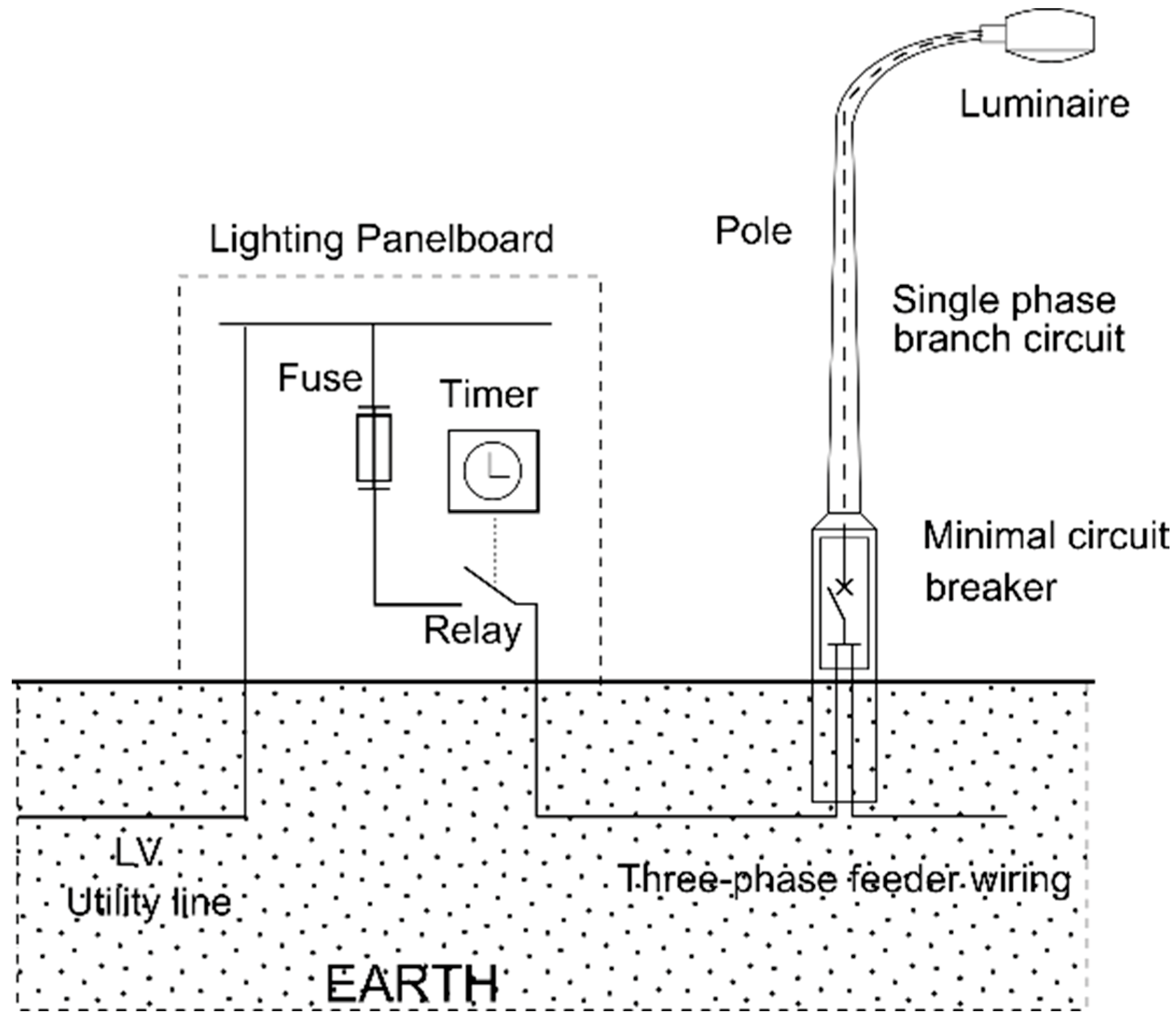
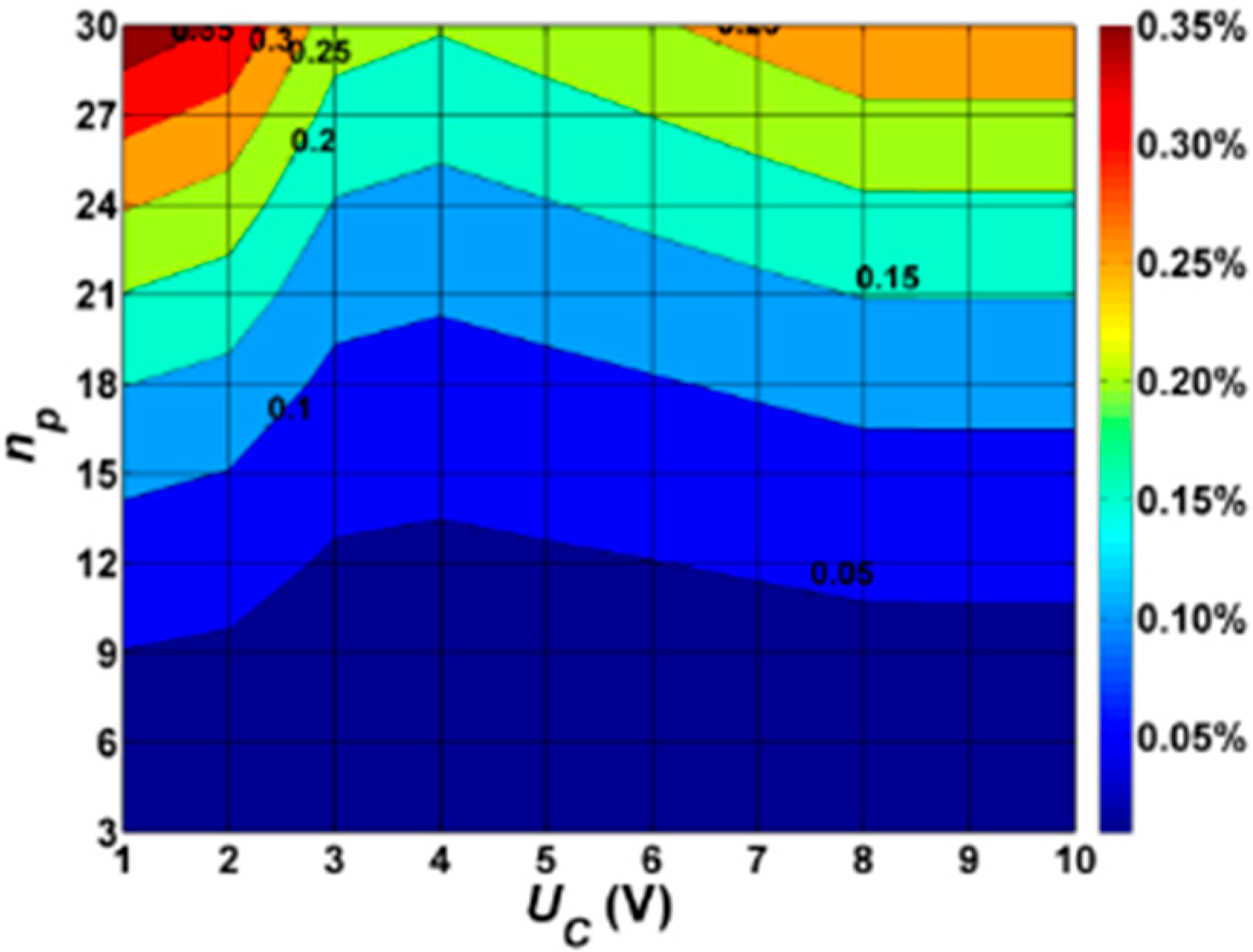
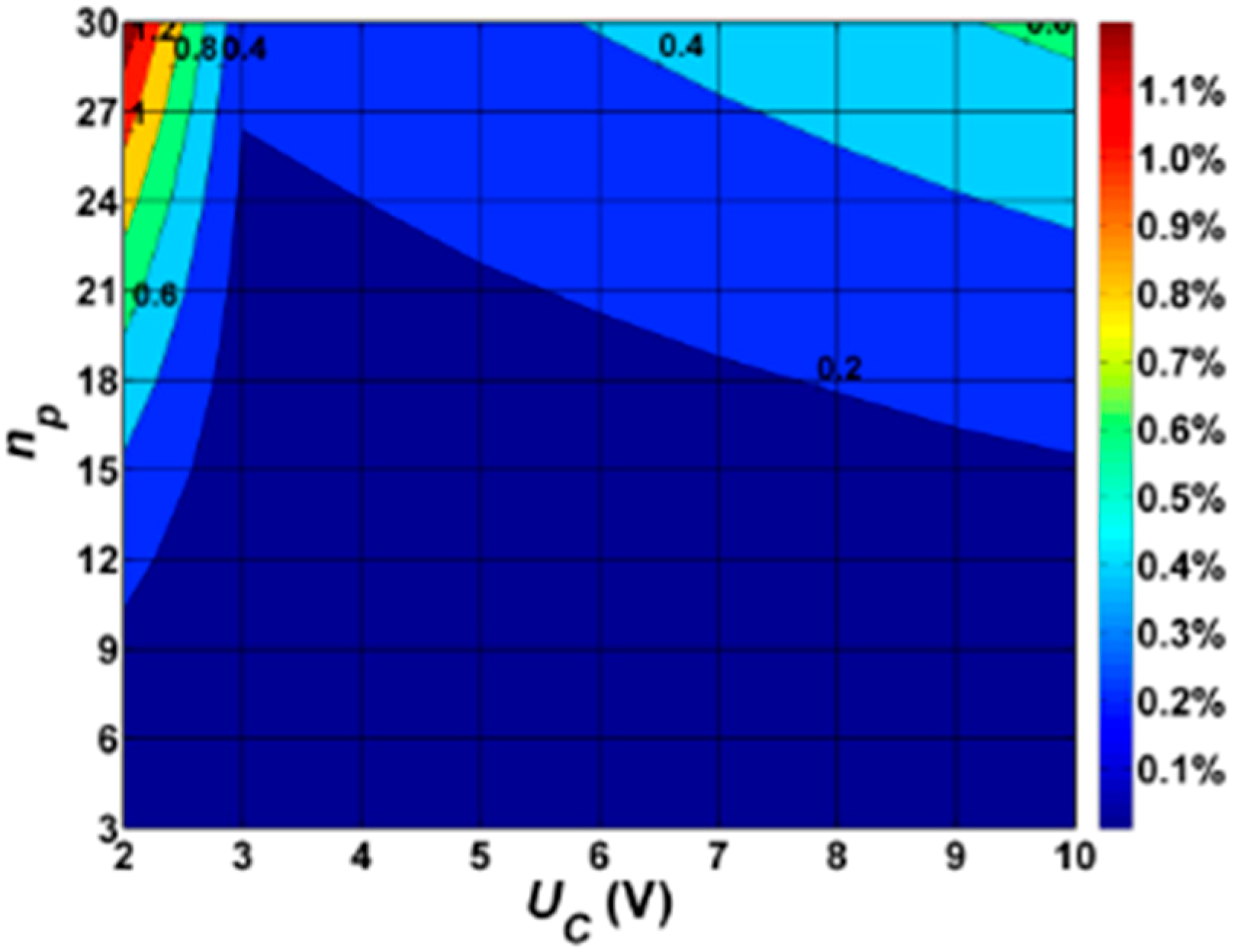
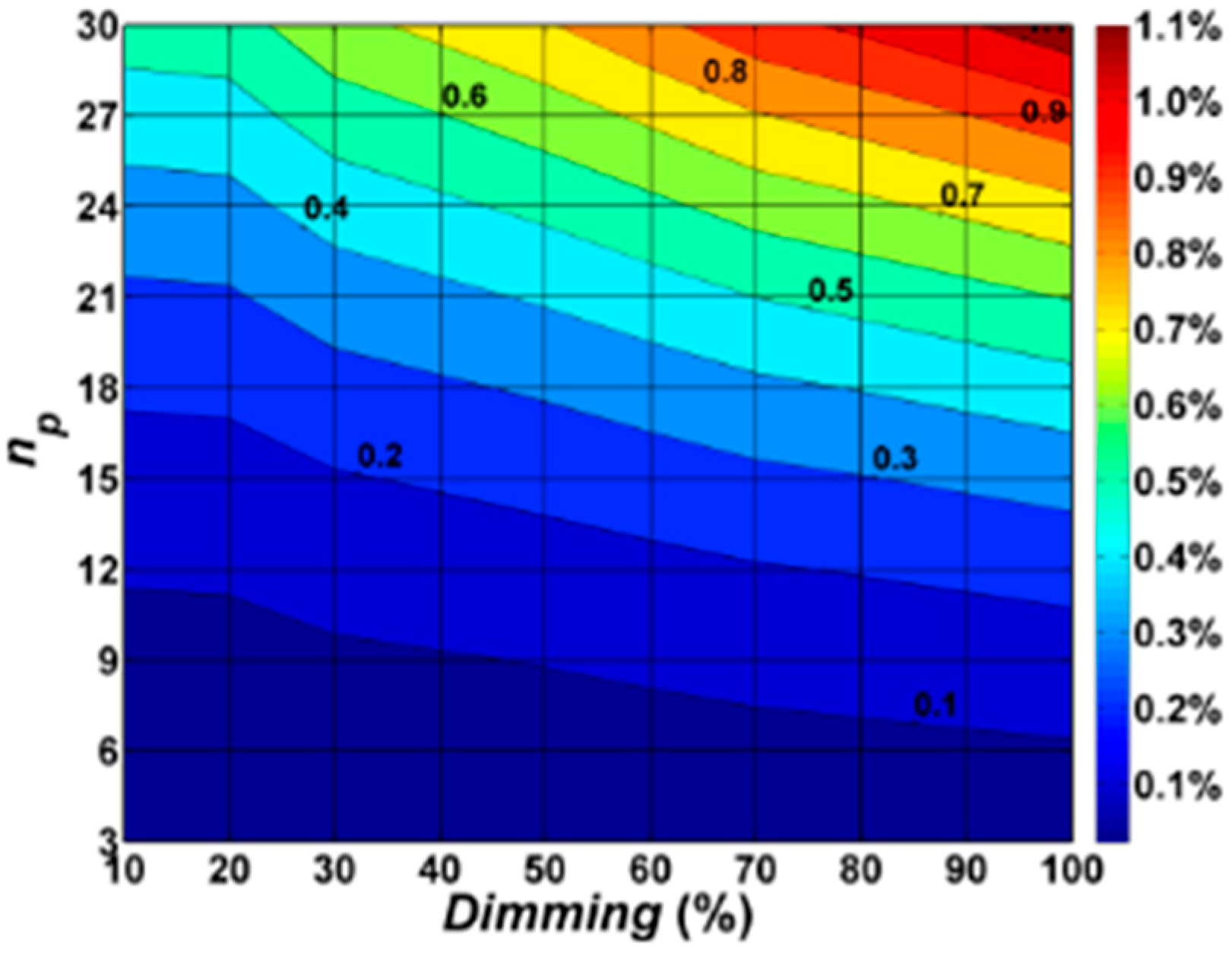
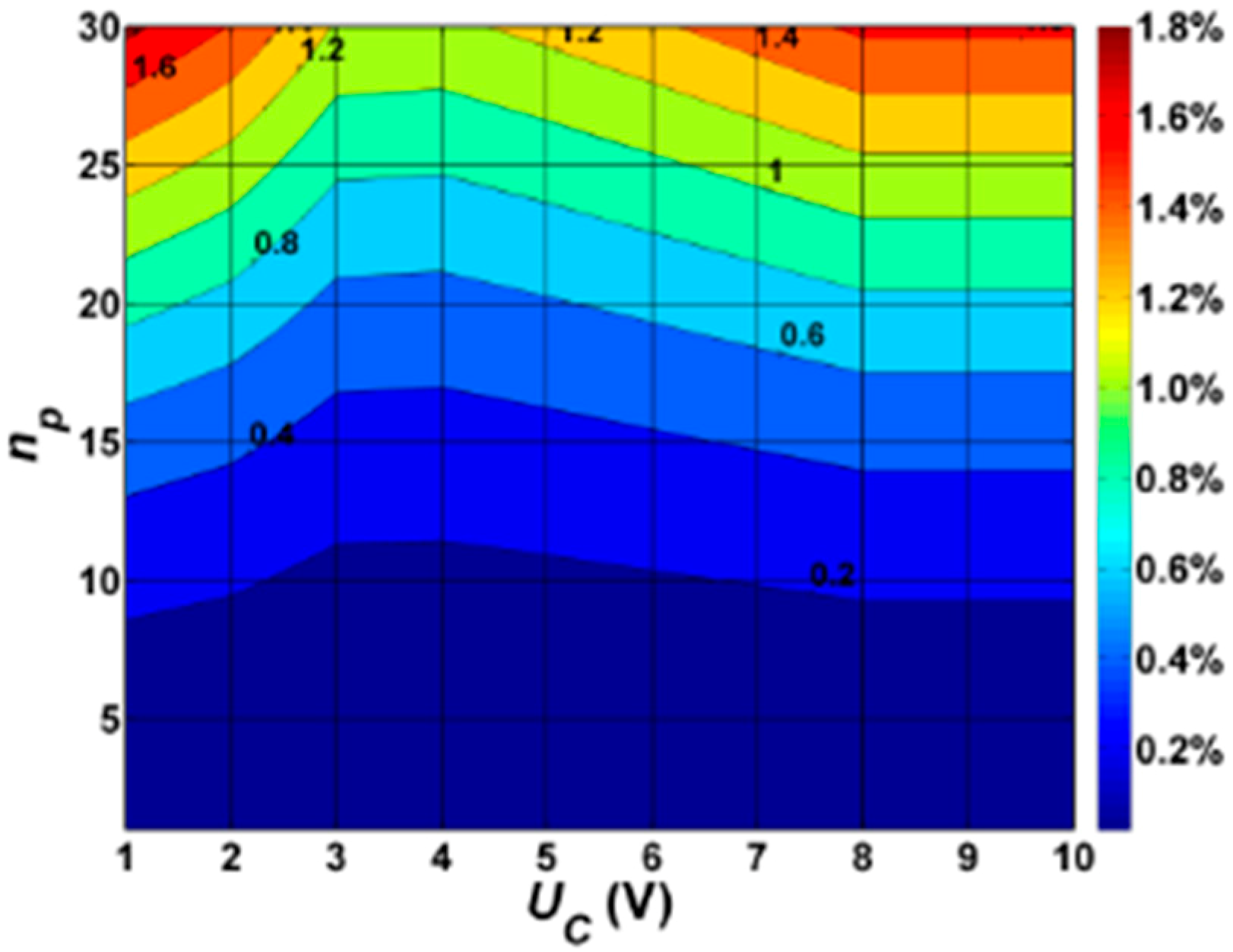
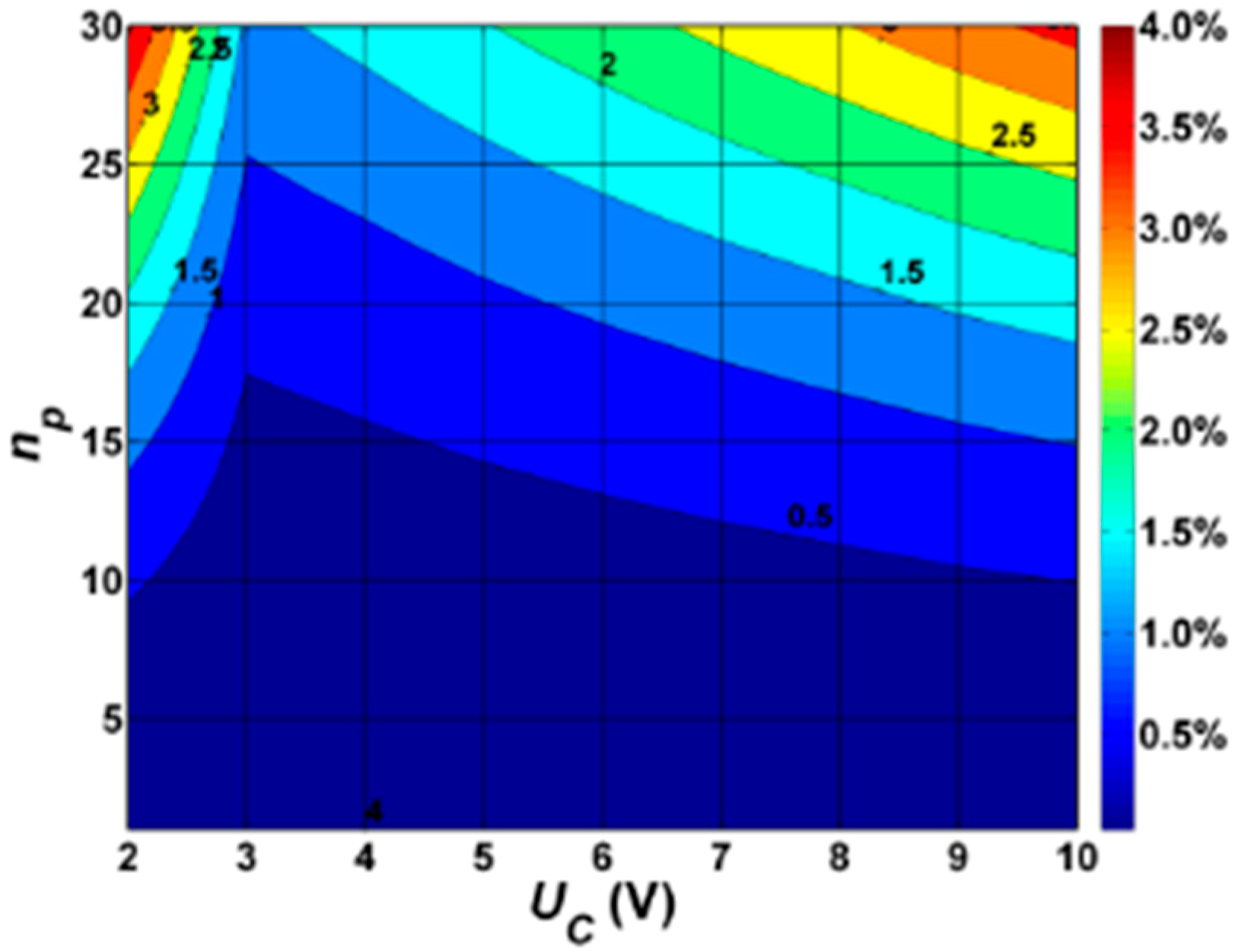
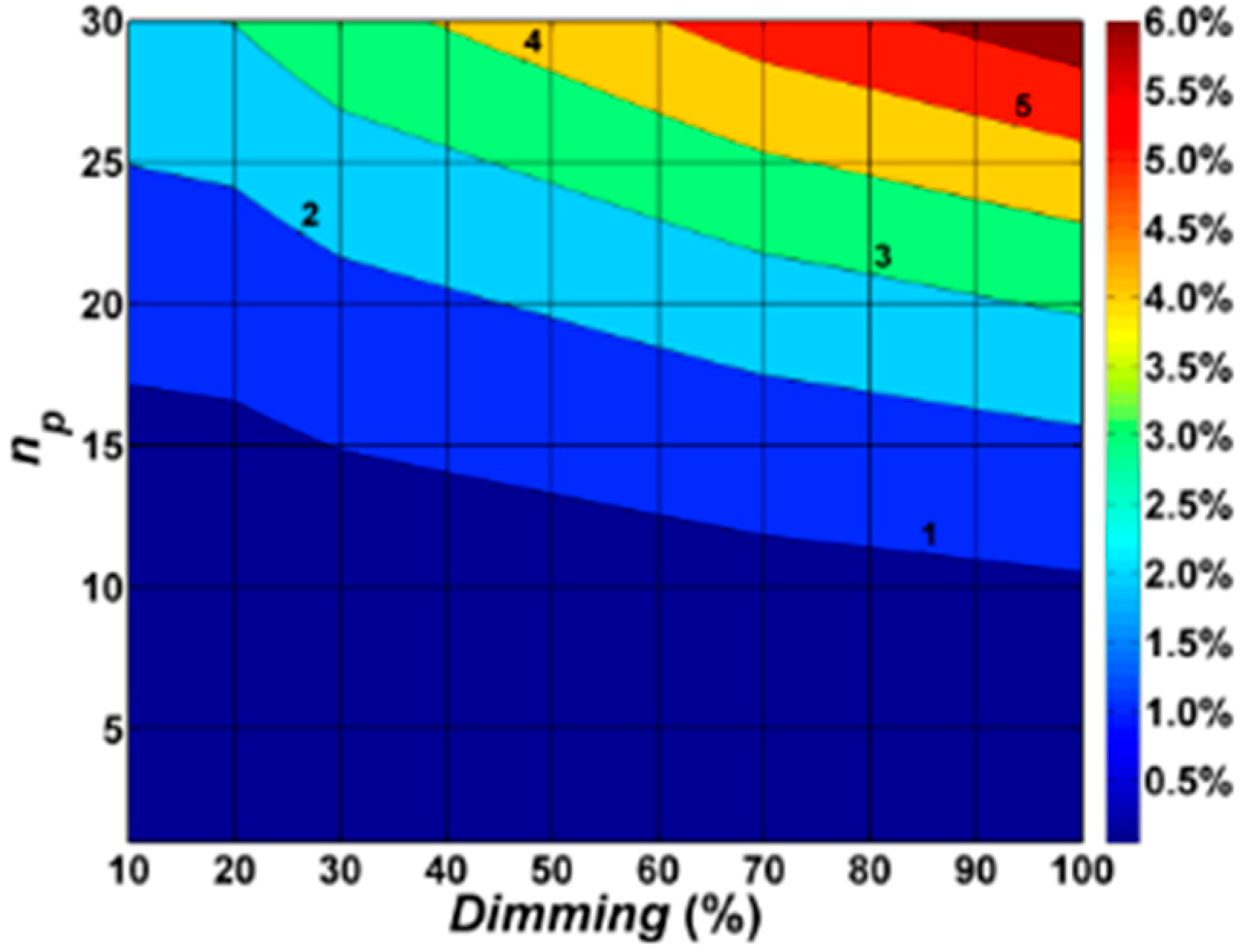
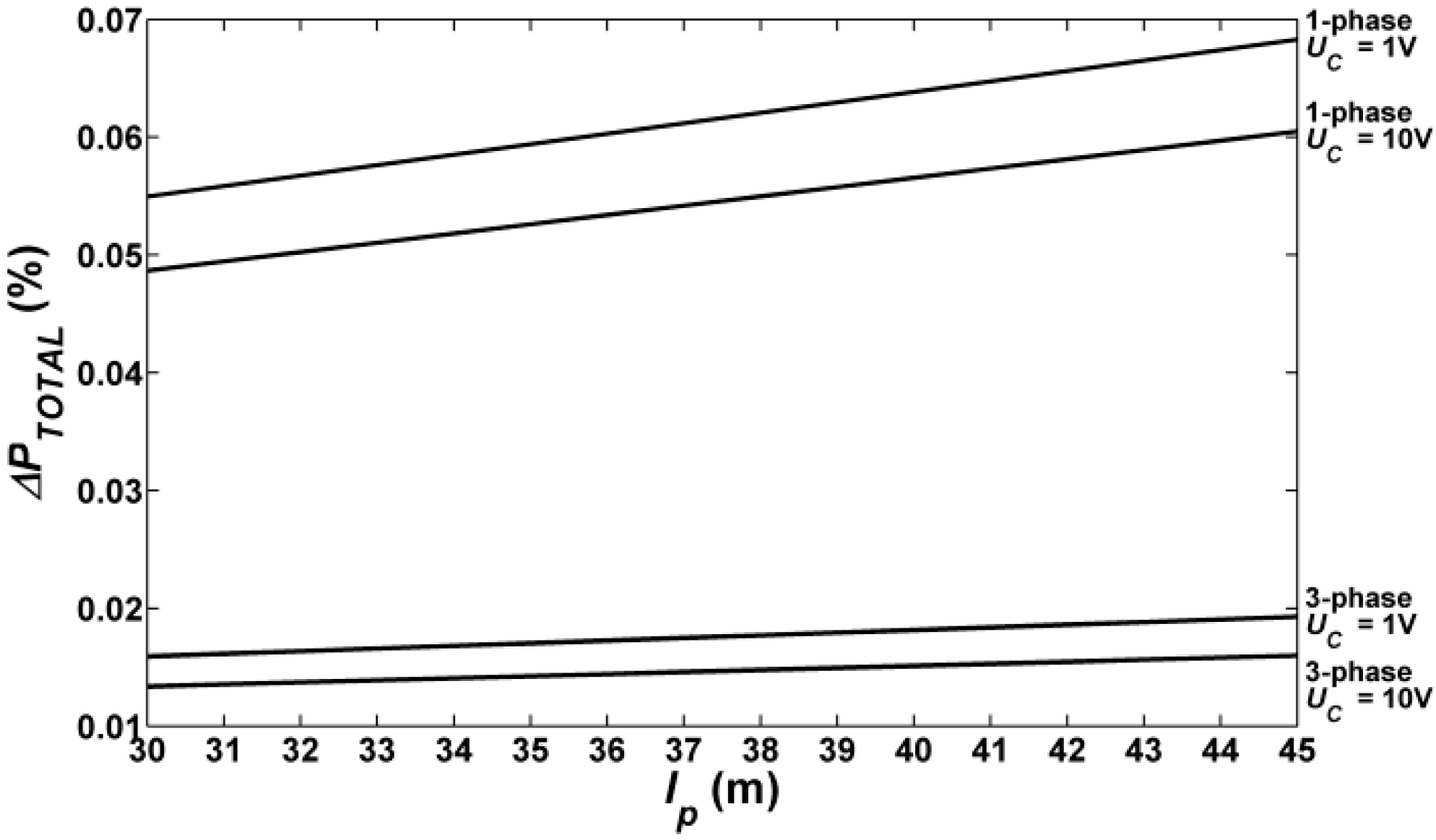
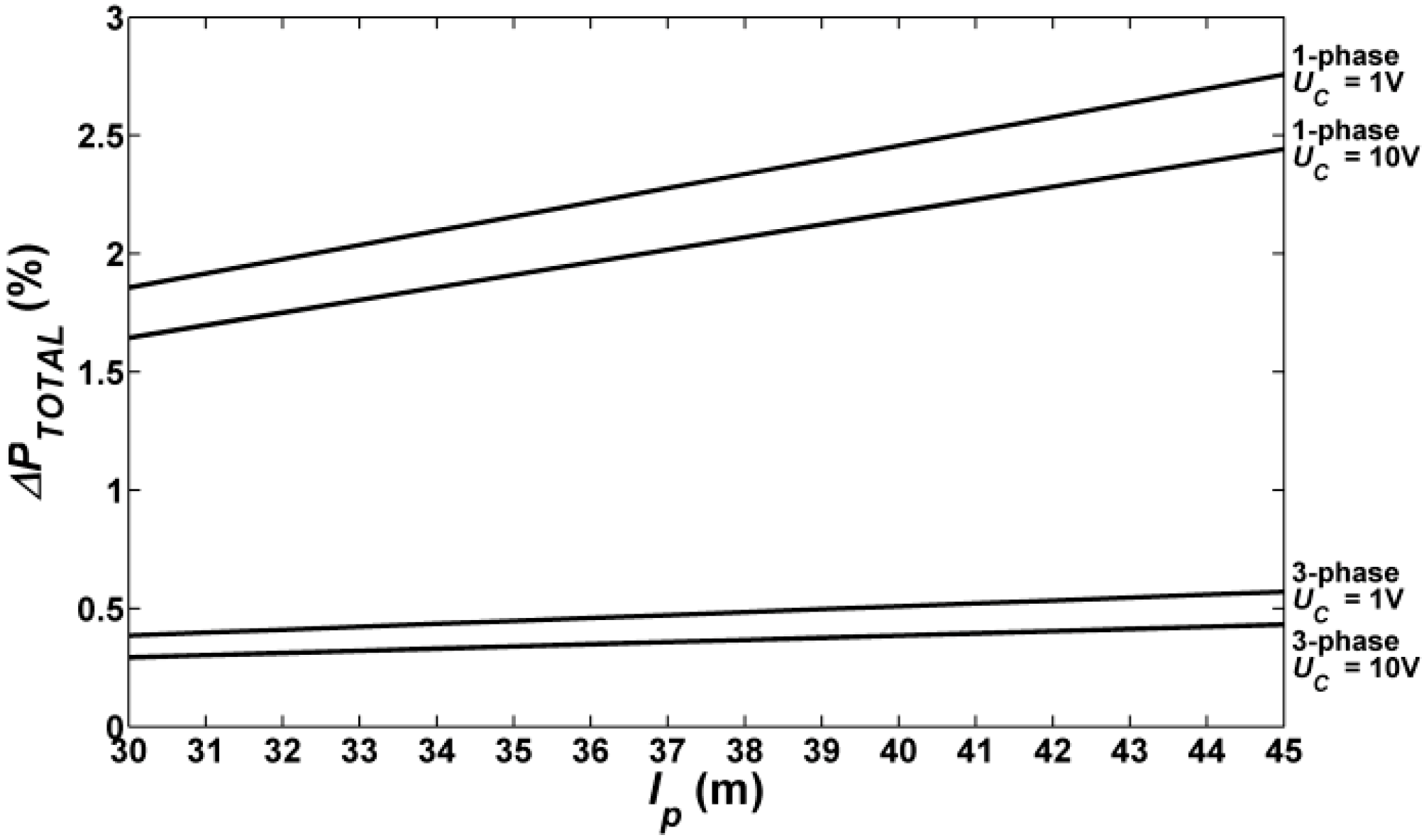
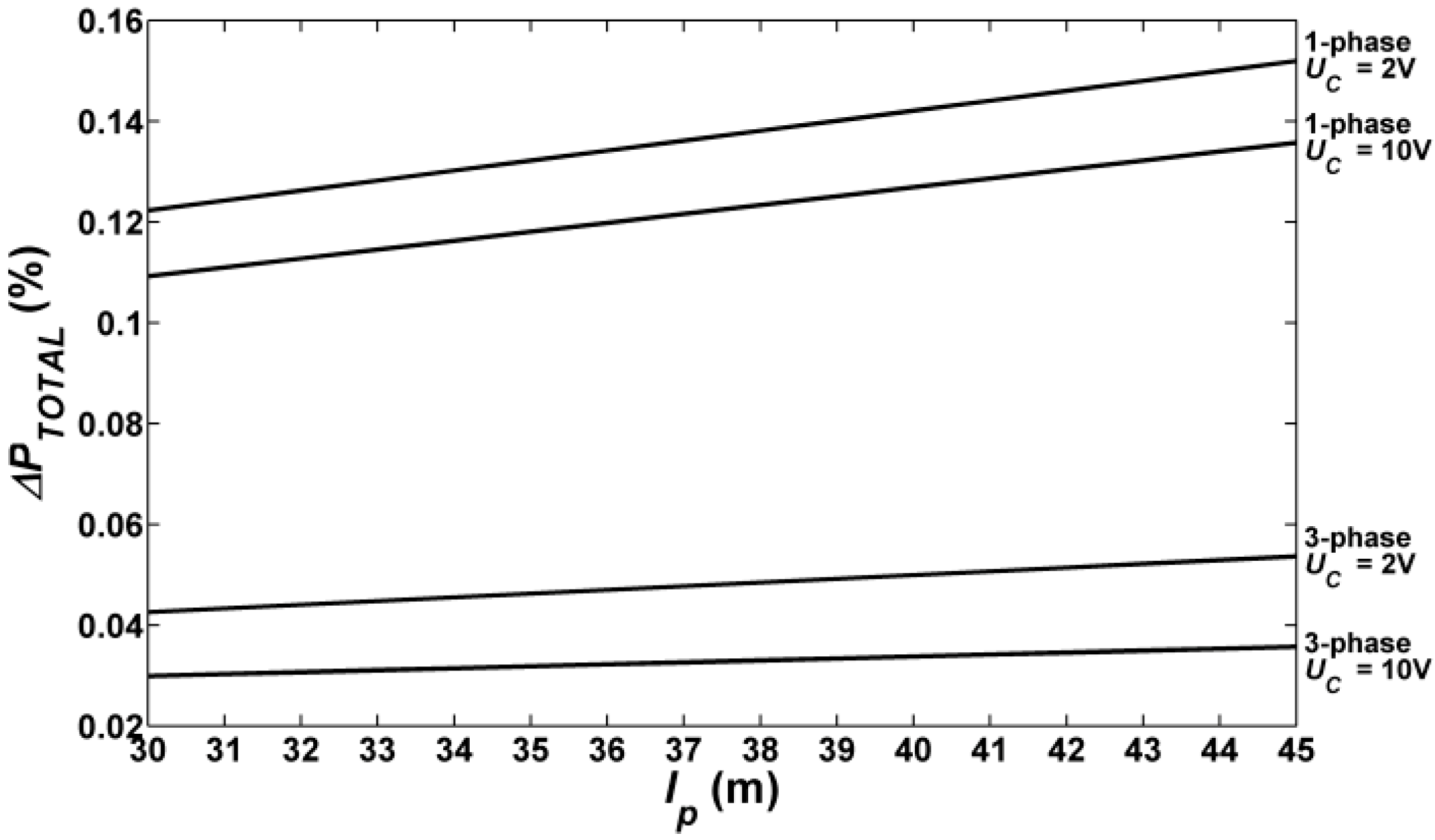
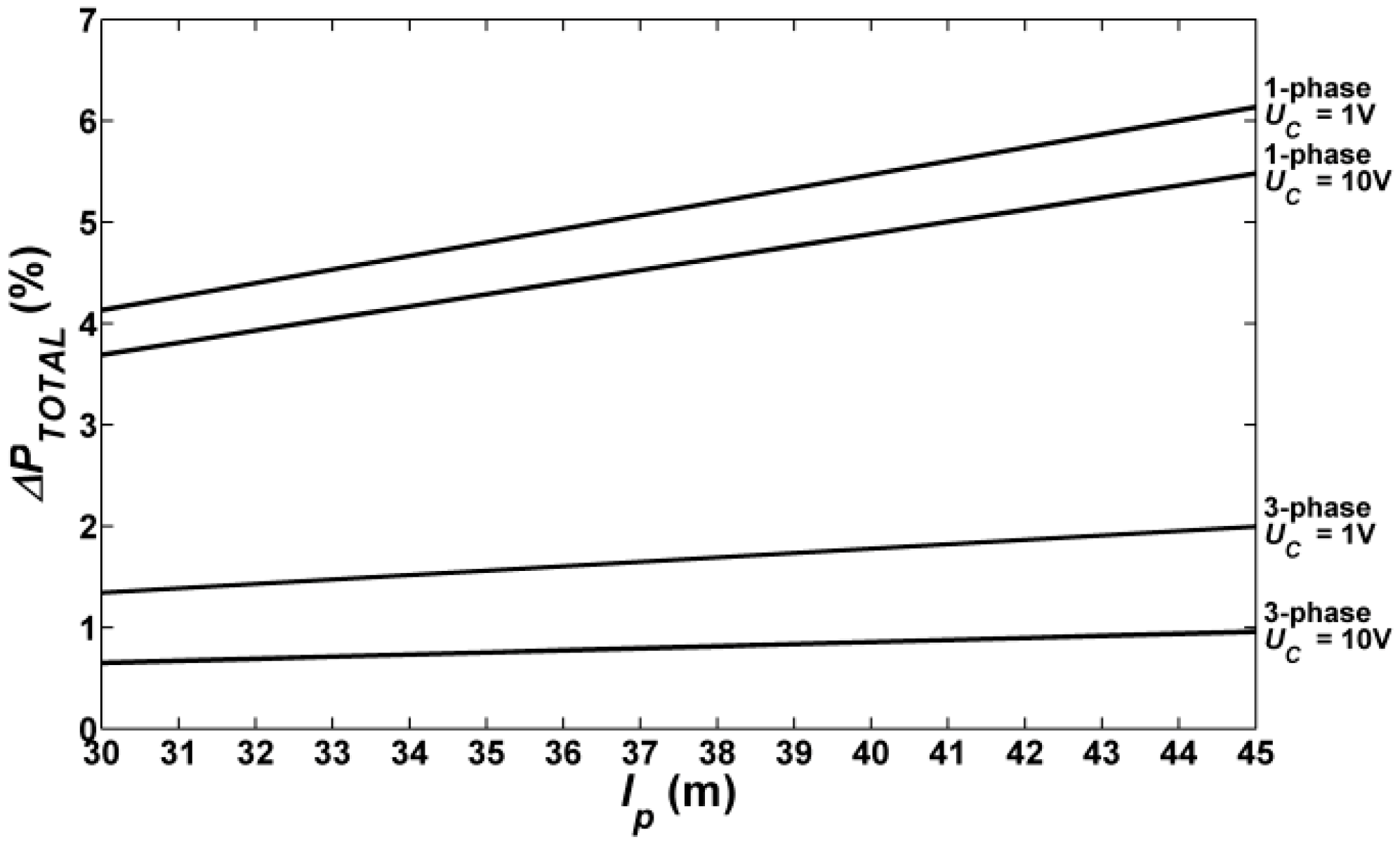
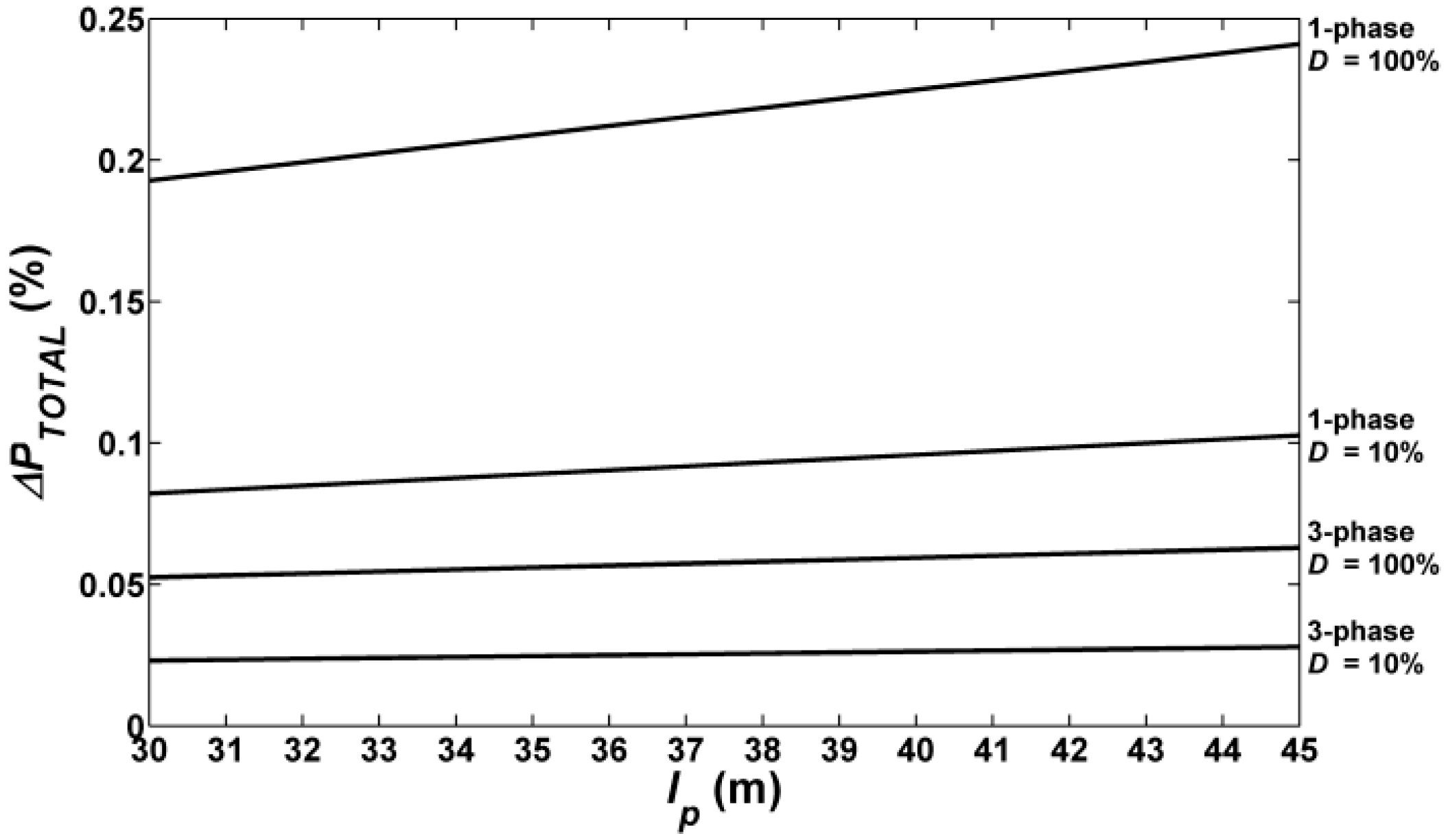
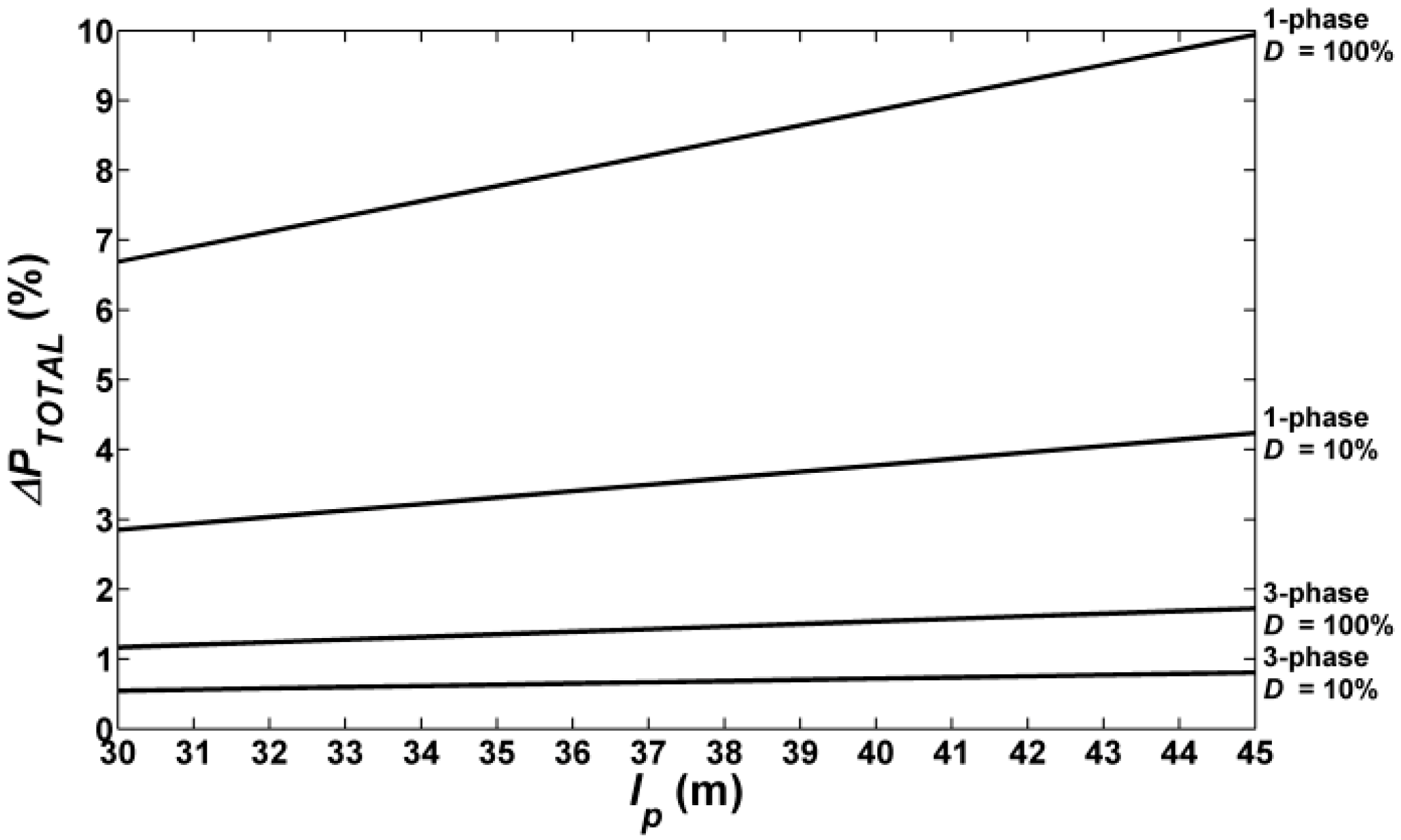
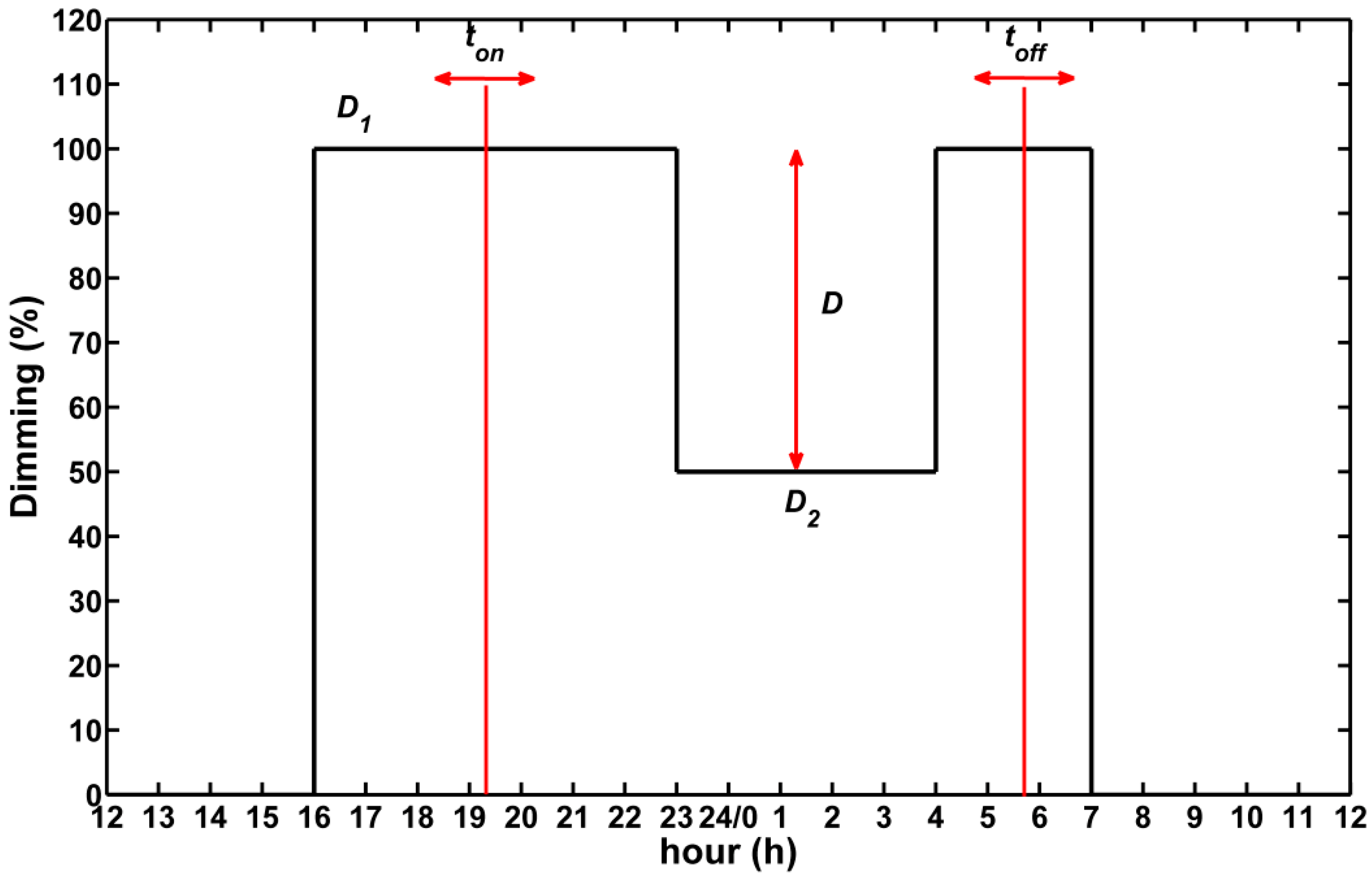
| Dimming UC (V) | Plum (W) | Qlum (var) | PFD (-) | tgϕ (-) | PFDD (-) | THDI (%) | Φ (lm) | ηLum (lm/W) |
|---|---|---|---|---|---|---|---|---|
| 10 | 32.483 | 14.791 | 0.910 | 0.455 | 0.901 | 13.917 | 2736 | 84.238 |
| 9 | 32.483 | 14.793 | 0.910 | 0.455 | 0.901 | 13.893 | 2736 | 84.238 |
| 8 | 32.509 | 14.776 | 0.910 | 0.455 | 0.902 | 13.854 | 2736 | 84.161 |
| 7 | 28.356 | 14.478 | 0.891 | 0.511 | 0.881 | 14.427 | 2409 | 84.941 |
| 6 | 24.480 | 14.110 | 0.866 | 0.576 | 0.857 | 14.903 | 2072 | 84.635 |
| 5 | 20.677 | 13.788 | 0.832 | 0.667 | 0.822 | 15.013 | 1747 | 84.643 |
| 4 | 16.624 | 13496 | 0.776 | 0.812 | 0.767 | 15.130 | 1388 | 83.505 |
| 3 | 12.845 | 13.642 | 0.686 | 1.062 | 0.668 | 22.199 | 1001 | 77.918 |
| 2 | 9.045 | 15.001 | 0.516 | 1.658 | 0.483 | 36.873 | 621 | 68.571 |
| 1 | 6.277 | 14.031 | 0.408 | 2.235 | 0.373 | 38.007 | 393 | 62.510 |
| Dimming UC (V) | Plum (W) | Qlum (var) | PFD (-) | tgϕ (-) | PFDD (-) | THDI (%) | Φ (lm) | ηLum (lm/W) |
|---|---|---|---|---|---|---|---|---|
| 10 | 83.744 | 17.870 | 0.978 | 0.213 | 0.966 | 13.319 | 12,011 | 143.432 |
| 9 | 75.194 | 17.197 | 0.975 | 0.229 | 0.962 | 13.716 | 10,941 | 145.511 |
| 8 | 66.419 | 15.450 | 0.974 | 0.233 | 0.959 | 14.715 | 9831 | 148.013 |
| 7 | 58.138 | 14.518 | 0.970 | 0.250 | 0.953 | 15.557 | 8705 | 149.725 |
| 6 | 50.046 | 13.113 | 0.967 | 0.262 | 0.946 | 16.611 | 7553 | 150.909 |
| 5 | 42.462 | 11.539 | 0.965 | 0.272 | 0.940 | 17.748 | 6361 | 149.812 |
| 4 | 34.313 | 10.255 | 0.958 | 0.299 | 0.924 | 19.592 | 5139 | 149.781 |
| 3 | 26.752 | 9.584 | 0.941 | 0.358 | 0.893 | 22.814 | 3956, | 147.888 |
| 2 | 16.969 | 5.958 | 0.944 | 0.351 | 0.411 | 202.060 | 2789 | 164.349 |
| Dimming | Plum (W) | Qlum (var) | PFD (-) | tgϕ (-) | PFDD (-) | THDI (%) | Φ (lm) | ηLum (lm/W) |
|---|---|---|---|---|---|---|---|---|
| 100% | 144.470 | 36.656 | 0.969 | 0.259 | 0.955 | 8.003 | 14,081 | 97.467 |
| 90% | 136.040 | 36.322 | 0.966 | 0.274 | 0.951 | 8.453 | 13,390 | 98.427 |
| 80% | 126.890 | 36.235 | 0.962 | 0.294 | 0.945 | 9.146 | 12,664 | 99.803 |
| 70% | 116.790 | 36.003 | 0.956 | 0.318 | 0.937 | 9.823 | 11,870 | 101.635 |
| 60% | 105.940 | 35.392 | 0.948 | 0.347 | 0.929 | 10.417 | 10,980 | 103.644 |
| 50% | 94.152 | 33.946 | 0.941 | 0.377 | 0.919 | 11.005 | 9971 | 105.903 |
| 40% | 81.129 | 32.537 | 0.928 | 0.424 | 0.904 | 12.336 | 8804 | 108.519 |
| 30% | 67.233 | 32.430 | 0.901 | 0.524 | 0.871 | 14.338 | 7437 | 110.615 |
| 20% | 51.050 | 30.495 | 0.858 | 0.680 | 0.823 | 16.838 | 5859 | 114.770 |
| 10% | 38.843 | 28.913 | 0.802 | 0.921 | 0.759 | 21.052 | 4579 | 117.885 |
| Luminaire | Dimming Variant | CO2 Emission (t) | |||
|---|---|---|---|---|---|
| LUM1 | Without dimming | D1 = 10 V | 3.006 | 3.012 | 3.040 |
| Diming variant 7 | D1 = 10 V, D2 = 7 V | 2.830 | 2.835 | 2.860 | |
| Diming variant 6 | D1 = 10 V, D2 = 6 V | 2.664 | 2.669 | 2.692 | |
| Diming variant 5 | D1 = 10 V, D2 = 5 V | 2.501 | 2.506 | 2.537 | |
| Diming variant 4 | D1 = 10 V, D2 = 4 V | 2.328 | 2.332 | 2.352 | |
| Diming variant 3 | D1 = 10 V, D2 = 3 V | 2.167 | 2.171 | 2.189 | |
| Diming variant 2 | D1 = 10 V, D2 = 2 V | 2.004 | 2.008 | 2.026 | |
| Diming variant 1 | D1 = 10 V, D2 = 1 V | 1.886 | 1.890 | 1.907 | |
| LUM2 | Without dimming | D1 = 10 V | 7.750 | 7.798 | 8.018 |
| Diming variant 8 | D1 = 10 V, D2 = 9 V | 7.385 | 7.428 | 7.630 | |
| Diming variant 7 | D1 = 10 V, D2 = 8 V | 7.010 | 7.049 | 7.233 | |
| Diming variant 6 | D1 = 10 V, D2 = 7 V | 6.656 | 6.692 | 6.861 | |
| Diming variant 5 | D1 = 10 V, D2 = 6 V | 6.310 | 6.343 | 6.500 | |
| Diming variant 4 | D1 = 10 V, D2 = 5 V | 5.985 | 6.017 | 6.163 | |
| Diming variant 3 | D1 = 10 V, D2 = 4 V | 5.637 | 5.666 | 5.804 | |
| Diming variant 2 | D1 = 10 V, D2 = 3 V | 5.313 | 5.342 | 5.472 | |
| Diming variant 1 | D1 = 10 V, D2 = 2 V | 4.895 | 4.930 | 5.067 | |
| LUM3 | Without dimming | D1 = 100% | 13.370 | 13.543 | 14.358 |
| Diming variant 9 | D1 = 100%, D2 = 90% | 13.010 | 13.173 | 13.943 | |
| Diming variant 8 | D1 = 100%, D2 = 80% | 12.619 | 12.773 | 13.501 | |
| Diming variant 7 | D1 = 100%, D2 = 70% | 12.187 | 12.332 | 13.021 | |
| Diming variant 6 | D1 = 100%, D2 = 60% | 11.723 | 11.859 | 12.503 | |
| Diming variant 5 | D1 = 100%, D2 = 50% | 11.219 | 11.347 | 11.950 | |
| Diming variant 4 | D1 = 100%, D2 = 40% | 10.662 | 10.782 | 11.349 | |
| Diming variant 3 | D1 = 100%, D2 = 30% | 10.068 | 10.182 | 10.716 | |
| Diming variant 2 | D1 = 100%, D2 = 20% | 9.376 | 9.482 | 9.980 | |
| Diming variant 1 | D1 = 100%, D2 = 10% | 8.854 | 8.956 | 9.437 | |
© 2018 by the authors. Licensee MDPI, Basel, Switzerland. This article is an open access article distributed under the terms and conditions of the Creative Commons Attribution (CC BY) license (http://creativecommons.org/licenses/by/4.0/).
Share and Cite
Sikora, R.; Markiewicz, P.; Pabjańczyk, W. The Active Power Losses in the Road Lighting Installation with Dimmable LED Luminaires. Sustainability 2018, 10, 4742. https://doi.org/10.3390/su10124742
Sikora R, Markiewicz P, Pabjańczyk W. The Active Power Losses in the Road Lighting Installation with Dimmable LED Luminaires. Sustainability. 2018; 10(12):4742. https://doi.org/10.3390/su10124742
Chicago/Turabian StyleSikora, Roman, Przemysław Markiewicz, and Wiesława Pabjańczyk. 2018. "The Active Power Losses in the Road Lighting Installation with Dimmable LED Luminaires" Sustainability 10, no. 12: 4742. https://doi.org/10.3390/su10124742
APA StyleSikora, R., Markiewicz, P., & Pabjańczyk, W. (2018). The Active Power Losses in the Road Lighting Installation with Dimmable LED Luminaires. Sustainability, 10(12), 4742. https://doi.org/10.3390/su10124742





